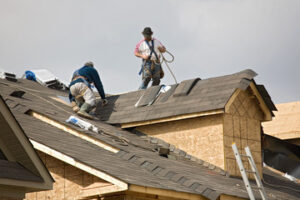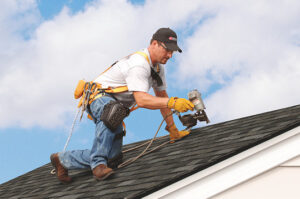A quality roof installation can protect your home and keep it safe from the elements. Roofing projects can be complex and require expertise to ensure the results are up to code and the job is done correctly.

Ensure that your contractor covers anything movable near your house with tarps. This will protect plants, furniture, and cars from falling shingles or nails. To learn more, visit http://www.fresnoroofingexperts.com/.
A roof replacement requires a blank canvas, and for that to happen, the old roofing materials need to come off. Rather than just overlaying the new roof on top of the existing one, a full tear off is usually the best option. This allows the roofers to check out the condition of the decking and make repairs if needed. This prevents the new roof from experiencing the same issues as the old roof and potentially leaking.
During the tear off process, the roofing contractor will first protect your home and yard by covering the plants, air conditioning units and anything else that might get damaged with tarps. They will also have a dump trailer or dumpster delivered and set up on your property to collect the debris as they go. They will then begin tearing off the shingles section by section. The crew will use shingle forks that allow them to easily slide under and lift the shingles up, making this an efficient process. The crew starts at the end of the roof furthest from their dump trailer and work their way back towards it. They’ll keep one eye on the dump container while the other makes sure that all of the shingles and other pieces of debris go into it and don’t wind up in your yard or bushes.
As you go along, be sure to clean up every nail you can find in the yard, as these can be a safety hazard for people walking in the area or when they mow the lawn. Also, make sure the crew isn’t dumping the waste too close to your house, as this can cause damage during the construction of the new roof.
Underlayment
Roof underlayment is a waterproof base that’s installed directly on the roof deck before any other material. It’s a vital part of your home’s defense against weather extremes, since it prevents water damage to the roof deck. It also helps shingles last longer by catching any water that seeps through.
Typically, roofing underlayment is made of felt or synthetic materials. Felt underlayment is the oldest type, and it’s still used on some homes. It’s generally affordable, though it can tear easily. It’s often made from cotton or paper fibers that are saturated with asphalt. The disadvantage is that it can be brittle over time, and it’s not effective in harsher weather conditions.
Synthetic underlayment, which is primarily used in new construction projects, is the preferred option for many professional roofing contractors today. It’s mainly made from non-bitumen polymers or a combination of these. It’s not as flammable as felt, and it’s much stronger and more resilient than other options. It also comes with printed lines, which help roofing professionals ensure the proper laps.
One of the most popular types of underlayment is rubberized asphalt, which was introduced a decade ago. This underlayment is a great choice for leak-prone areas like eaves, valleys, chimneys, skylights, and vents. It’s primarily made from rubber and asphalt, but the exact composition varies from product to product. The advantages of this underlayment are its ability to repel moisture, and it’s extremely durable against wind-driven rain. It also has a high traction surface that makes it safer for workers to walk on a rooftop during installation. It’s also a great choice for homeowners who want to save money on their energy bills by reducing heat transfer.
Shingles
When it comes to shingles, there are many types and styles. However, most are installed using the same basic techniques. Whether you choose 3-tab asphalt, architectural or random cutouts, all are laid in a similar manner.
Prior to installing shingles, install a new drip edge (sometimes called a fascia). The drip edge covers the roof’s eaves and should extend at least 4 inches past the rake edges. This will keep rain and snow from flowing under shingles and into the house. It also helps with ice dam protection in areas that get a lot of snow and heavy rain.
Next, lay a layer of felt or another underlayment to prevent water from seeping up under shingles. The underlayment may be self-adhesive, and it adheres tightly to the bare roof sheathing. Most building codes require it for regions with severe weather conditions, and it can be purchased at roofing supply companies and home centers.
Begin shingling by installing a full starter shingle along the eaves and ridge, and then lay out successive rows in a stair-step pattern. This will ensure that the bottom of each shingle slightly overlaps the shingles above it, which will help prevent a patchwork appearance. If you’re unsure how to do this, consult the shingle manufacturer’s directions.
Before you start laying shingles, be sure to locate and remove any old flashing. This includes the flashing around chimneys and vents, as well as valleys where two roof planes meet. Also, be sure to remove and reinstall any metal ridge caps if they were removed during the tear off process.
It’s a good idea to tarp or cover all plants and landscaping in front of your house before you begin. This will protect them from the thousands of nails that will fall off the roof. Also, place large tarps where you plan to work to catch the shingle debris as it falls.
Flashing
The most important part of the roofing system, flashing prevents water from getting under the shingles and into your home. A small amount of water trapped underneath a roof can cause rot, mildew, and pest infestation. Flashing is the metal that surrounds protrusions on a roof, like chimneys and vent pipes, as well as any cracks or seams in a roof. Flashing is a thin, flat piece of metal that helps keep water from seeping into these areas.
There are several different kinds of flashing. Barge flashing is used to protect the edges of a chimney by ensuring rainwater hits an area that will direct it down and away from the home. Valley flashing is used in the intersections of two sloping roof sections, which are notorious spots for water penetration if not properly flashed.
Flashing around vents and piping is generally T-shaped with a central spout opening, made either of metal for a vent top or of rubber compression fitting to wrap over a pipe. This type of flashing slips over the pipe or vent to create a waterproof seal and prevents rainwater from flowing back up under the shingles and into your house.
A roofer will use a tool called a brake to bend aluminum flashing to the shape and size needed for each project. They may also use other metals, including lead or copper, for flashing on older buildings that still have these materials in place.
Other flashings include counter flashing, which is sheet metal that slides under a run of base flashing on a vertical surface. It’s a good idea to replace all flashing on a re-roofing job, because the old flashing will likely begin to leak long before your new roof will need replacing.
Ridge Cap
Ridge caps are specialty shingles that cover the ridge of your roof, creating a finished and aesthetically pleasing look. They also serve important functions such as preventing pests and rodents from entering your attic through holes, cuts, and roof ridge gaps. They prevent ice dams from forming and help keep your home cool and dry by allowing air to escape the attic through ridge vents.
They install much like regular shingles, but are designed to overlap with your existing shingle roof layers. When installing a ridge cap, it is important to check the design and instructions to ensure that it fits correctly. Otherwise, you could have problems with water intrusion, and the shingles may become damaged.
Once the ridge cap is in place, you can complete the installation with a strip of sealant tape to prevent rain and snow from seeping through the gap. You should use a longer nail coil when installing these shingles than you would for the field shingles because they need to penetrate through the additional layers of your roof.
There are several different types of ridge caps, including solid and vented closures, skylight ridge caps, and formed ridge caps. Each type has its own unique design and installation requirements.
When choosing a ridge cap, it is important that you choose a high-quality product from an established roofing company. They will be able to advise you on the best options for your roofing system and provide a professional installation. They will also be able to give you an accurate cost estimate.



